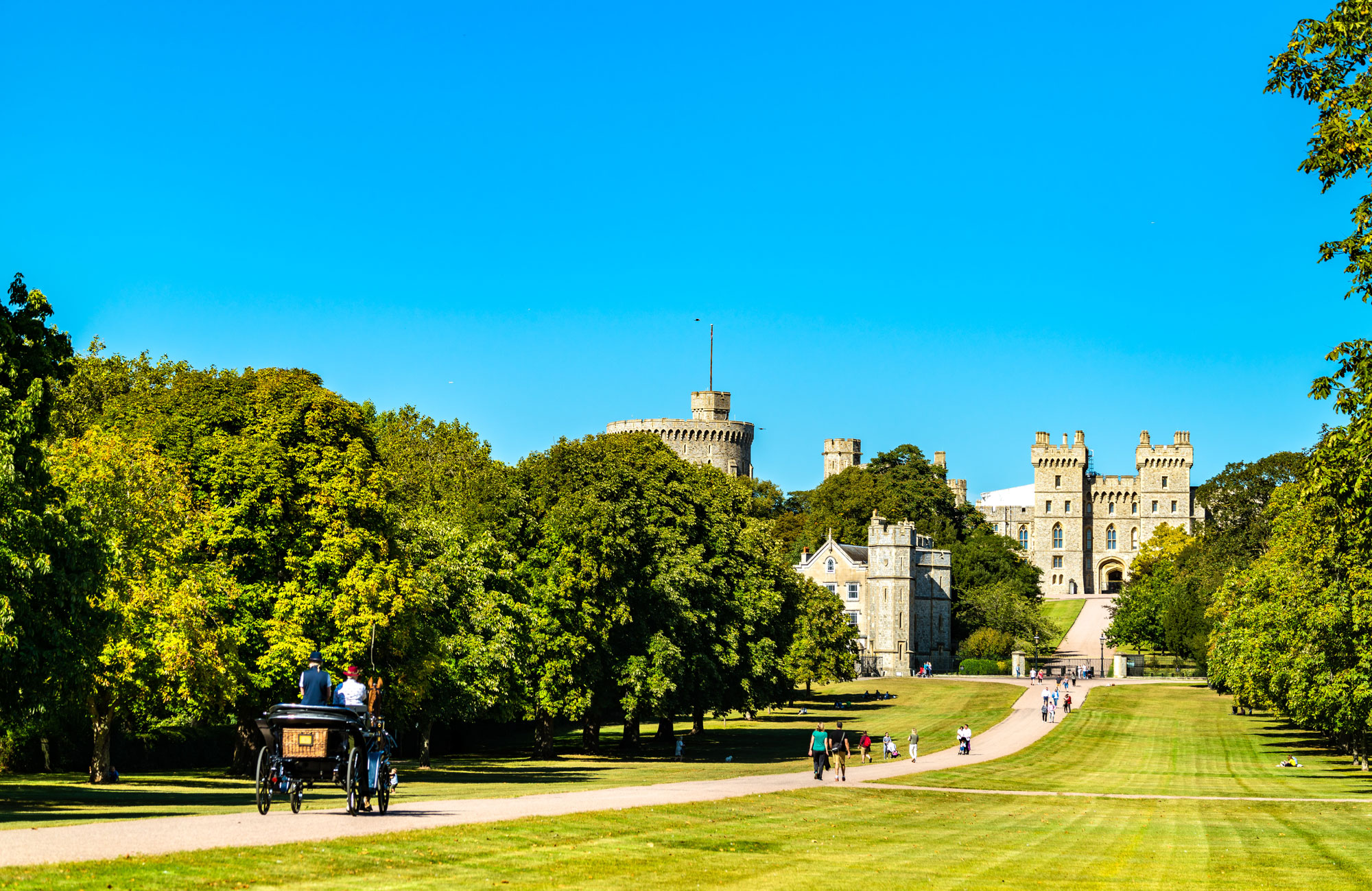- Home
- English Castles
- Windsor Castle
WINDSOR CASTLE

A brief history
Constructed by William the Conqueror in 1066 Windsor Castle is the oldest and largest occupied castle in the world. Built on a chalk cliff overlooking the river Thames the site is three miles from the original Saxon settlement at Old Windsor where Edward the Confessor had his hunting lodge.
Henry II erected the stone castle on the site of William’s large motte. There are three baileys – lower, middle and upper – and by the end of Henry’s reign it was a formidable fortress.
Henry III built the west wall and its towers flanking the main street. The first chapel was built where the Albert Memorial Chapel stands. This was made the centre of the new Order of the Garter by Edward III, who established a college with poor knights to organise the Order.
St George’s Chapel was started in 1475 by Edward IV and completed by Henry VII. The body of Henry VI was moved from Chertsey to the chapel in 1485.
Elizabeth I added the gallery, which now forms part of the library, and the North Terrace, which was built so that the Queen could reach the Home Park without going through the State Apartments.
The next king to alter the castle was George III, who lowered one of the walls and erected a new window in the chapel.
Queen Victoria turned the old chapel into a memorial chapel for Prince Albert and a small chapel has been built to the memory of George VI.
Home to the former Queen and over 950 years of Royal History are waiting to be explored.
tHINGS TO DO
THE PRECINCT TOUR
Take a tour of the Castle exterior to get a feel of what’s in store for you once you step into the interior of The State Apartments, St Georges Chapel and all the other magnificent works of Art and Splendour you are about to experience.
This tour introduces the Castle’s 1000 year history and it’s role today as an official working palace of King Charles III. Not to be missed.
THE STATE APARTMENTS
Explore the glorious State Apartments which includes the fantastic Grand Reception Room with its glittering chandeliers. You can also see the rooms built for Charles II, who hoped to rival the grandeur of Versailles.
You can choose between The Ceremonial Route and The Historic Route.
The Ceremonial Route will take you to the main State Apartments which were used by The Queen and members of the Royal Family. Here The Queen hosted official visits by Heads of State from other countries and also hosted awards ceremonies to recognise the achievements of many British nationals.
The historic route will show you the rooms that were built for Charles II and his Queen, Catherine of Braganza.
Now the State Apartments are only open when the current Monarch is not in residence. If the royal flag is flying above the castle the Monarch is present and you cannot visit see the State Apartments.
THE SEMI - STATE ROOMS
These magnificent rooms were used by the Queen for official entertaining.
Originally created as private apartments for George IV, the king completely changed the castle’s exterior in the 1820’s and created a new suite of private rooms on the south and east side of the castle with the help of his architect Sir Jeffry Wyatville.
The Semi-State Rooms were badly damaged by the big fire of 1992 and a huge effort was made to restore them to their 19th century look.
ST. GEORGE'S CHAPEL
St George’s Chapel is a fine example of the Perpendicular style of Gothic Architecture in England.
This chapel was designed for the Order of the Garter and was begun by Edward IV. Above the choir stalls hang the insignia of the Knights of the Garter, their swords, helmets and banners.
St George’s Chapel is also famous for another big attraction – Royal Weddings. The wedding of the Duke and Duchess of Sussex (Harry and Meghan) took place in this chapel.
Inside the chapel lie the tombs of 11 monarchs, including Charles I, Henry VIII and his third wife Jane Seymour, the late Queen, Elizabeth II and her husband Prince Phillip.
ALBERT MEMORIAL CHAPEL
The Albert Memorial Chapel was dedicated to the memory of Prince Albert, Queen Victoria’s husband, who died in 1861. The Queen agreed to a proposal to remodel the Wolsey Chapel inside St George’s chapel into a memorial which the public could visit as well.
Work began in 1862 with Sir George Gilbert Scott as her appointed designer, it was completed in 1875 and renamed the Albert Memorial Chapel.
The interior is beautifully decorated with coloured marble and mosaics. George III, George IV and William IV are buried in this chapel.
QUEEN MARY'S DOLLS HOUSE
The Queen’s Doll’s House is a palace in perfect miniature and was given to Queen Mary in 1923.The house was designed by Sir Edwin Lutyens and it is a masterpiece that took 3 years to complete.
Each room is exquisitely furnished with every item made to scale and includes contributions from the finest craftsmen and artist of the early 20th century.
The Doll’s House includes working lifts, running hot and cold water and it even has electricity to switch on the lights in every room.
CHANGING THE GUARD
The Changing the Guard at Windsor Castle is a colourful spectacle and one of the highlights of a visit to the Castle.
Changing the Guard is a formal ceremony in which the group of soldiers currently protecting Windsor Castle are replaced by a new group of soldiers belonging to the Household Troops. This duty has been carried out since 1660.
The ceremony doesn't take place every day, so make sure to check in advance for dates and times.
MOAT ROOM
Visit the Moat Room to see a large scale bronze model of Windsor Castle in 1377. You will get an idea of how the Castle looked in the past and might wonder if this is not one of the greatest medieval castles in Europe.
There is a timeline that runs along one side of the wall illustrating reigning monarchs.
THE HORSESHOE CLOISTERS
These are houses of the Military Knights of Windsor who are also members of The Most Noble Order of the Garter.
Known as the Horseshoe Cloisters built in 1479 the building has a brick and timber frame with an unusual pattern. The timbers are formed into delightful picturesque shapes and the brickwork displays a diagonal pattern, which looks very pretty.
THE TOWERS
The Round Tower was built by Henry II and is surrounded on three sides by a moat. You can climb its 200 steps for an amazing view of the castle complex and the Long Walk. On a good day you might just make out the London Skyline.
The Curfew Tower was built in 1227 and is one of the oldest surviving buildings among the Lower Ward’s. Hiding within is part of a 13th century dungeon.
LOCATION
Windsor Castle is a Royal Residence at:
Windsor, Berkshire
Castle Hill, Windsor, SL4 1NJ
Official Website: Windsor Castle
Visit Windsor Castle's Practical Information Page for updated information

